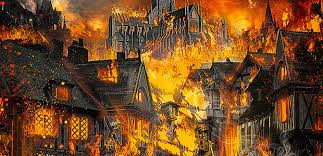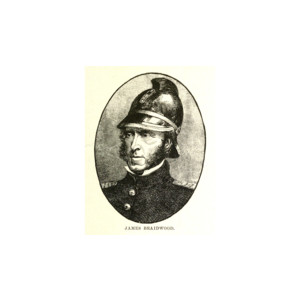The Great Fire of Edinburgh

The Great Fire of Edinburgh
Most people have heard of the Great Fire of London, but the Great Fire of Edinburgh might be more significant, since it heralded in the modern era of British firefighting. Edinburgh in the 1800s was ripe for fire, since most of the overcrowded tenements of Old Town were constructed from wood, were several stories high and very close together. The fire began in an engraver’s shop, the culprit being an overheated pot of linseed oil.

James Braidwood
This was the first real test for pioneer firefighter James Braidwood, appointed Master of Fire Engines at age 24, just two months prior to the Great Fire of Edinburgh in November 1824.
Braidwood was a good choice for the job since his father owned a construction company, so his background as a surveyor and knowledge of how buildings were assembled held him in good stead during his days as a firefighter. He recruited tradesmen and mariners as firefighters, valuing their expertise and their brute force. His practical organization and methodology were adopted throughout Britain. But due to the unfortunate timing of the fire in Edinburgh, he had limited time to train his firefighter recruits before the massive blaze broke out. As a consequence, the firefighters had trouble finding the water supply so the blaze burned out of control for over an hour before they could begin tackling it.
The fire service in Edinburgh was so new that local public officials issued contradictory instructions to those fighting the fire, adding to the confusion. As a result of this fire, new regulations were passed to give complete control to the firefighters in future emergencies. Also, the number of watering outlets available to the firefighters was raised throughout all of Great Britain.

The fire lasted for five days and took out over 400 residences, leaving 500 families homeless. Thirteen people died in the fire, including two firemen. The Tron Kirk, a local parish, had a spire comprised of lead, which became molten during the fire, dripping from the building and adding to the chaos and destruction. Many residents thought they had incurred the wrath of God. The cost was deemed to be in excess of 200,000 pounds, a huge amount at the time. Many of the oldest architecture in town was destroyed.
James Braidwood was distinguished for his heroism during the fires of Edinburgh and a few years later in London. In 2008, he was honored with a statue in Edinburgh.
Account of the fire from the Edinburgh Evening Courant
“The fire however spread resistlessly… The roof of the adjoining house on the east side of the Square first appeared in a flame, and the fire afterwards broke out in the angle towards the Square from the windows and shop doors. From these it ascended in one continuous blaze up the front of the building; and about five o’ clock in the morning all the eastern side of the Square, not consumed by the recent fire (of June last) presented one huge burning tower, the beams crashing and falling inwards, and every opening and window pouring forth flame. The scene was now awfully grand; and could we have divested ourselves of the thoughts of the losses, and hardships, and ruin, which attended the progress of the conflagration, we could not have been placed in a situation where we could have derived such a portion of sublime enjoyment.
“The whole horizon was completely enveloped in lurid flame. Spinicular columns of flame shot up majestically into the atmosphere, which assumed a dusky, reddish hue; dismay, daring, suspense, fear, sat upon different countenances, intensely expressive of their various emotions; the bronzed faces of the firemen shone momentarily from under their caps as their heads were raised at each successive stroke of the engines; and the very element by which they attempted to extinguish the conflagration seemed itself a stream of liquid fire.
“The clattering of the horses hoofs and the light reflected from their riders swords added a kind of martial terror to the scene, and when we beheld the whole, surrounded either with burning piles or with edifices that reflected a light more fearful than even that which was thrown upon them, we felt a thrill of mingled fear and admiration. The County Hall at one time appeared like a palace of light; and the venerable steeple of St. Giles’s reared itself amid the bright flames like a spectre awakened to behold the fall and ruin of the devoted city.”
http://www.witcherytours.com/blog/2014/11/16/day-16-november-1824-great-fire-edinburgh
https://en.wikipedia.org/wiki/James_Braidwood_(firefighter)
https://inews.co.uk/inews-lifestyle/travel/great-fire-edinburgh/
https://www.scotsman.com/lifestyle/lost-edinburgh-the-great-fire-of-edinburgh-1-3029833
https://en.wikipedia.org/wiki/Great_Fire_of_Edinburgh
Becky Lower writes mostly American and Regency romances. In addition to History Imagined, she has a weekly blog at http://beckylowerauthor.blogspot.com.
Click here to find out more about Becky’s books: http://www.beckylowerauthor.com
Marvelous post Becky! The history of firefighting is fascinating. Ben Franklin founded what we have here in the eastern wilds of Pennsylvania.
LikeLiked by 1 person
The history of firefighting in the US would be a fun piece to research too, especially if it involves Ben Franklin.
LikeLike
Wow. That was fascinating, Becky.
LikeLiked by 1 person
Thanks, Jude. I was in CA a few years ago when the fires were all around us and got to see first hand what’s involved with fighting fire. To read about its beginnings was quite interesting.
LikeLike
Great post, Becky! Love Edinburgh and Scottish history!
LikeLiked by 1 person
Wow, that description is very vivid and spine-chllling. We take for granted these days that most fires will be extinguished quickly and not destroy more than one building, even in a city. Of course, the new scourge may be forest fires, which are predicted to get more common and more intense in the upcoming years. We’ve gone from living in crowded wooden dwellings that are a fire hazard, to living in wild forested areas, which now represent a huge fire hazard. Human ingenuity will have to adapt and we’ll need new, far-thinking heroes. Great post!
LikeLiked by 1 person
Thank you, Mary, for visiting History Imagined today. Glad you enjoyed the post. I agree that forest fires have overtaken city fires as a huge hazard. It’s hard to get a grasp of the enormity of the problem until you’re in the middle of one.
LikeLike
oh nice job, Becky.
BUT as a retired VOLUNTEER FIREFIGHTER– I OBJECT to the term –brute force for those fire service recruits. The men who were recruited had to be very strong & agile & mentally tough–not only in brute STRENGTH, since the physical and mental demands of the fire service were quite something.(Still are)
Equipment at that time was bulky and very heavy; constructed of thick leather–hoses, boots coats; jackets; helmets. Or wood with iron and steel trim–engines, buckets; hoses
Sailors were perfect recruits for this since on a ship– EVERYONE is a firefighter. Sailors would not be strangers to the risks that one would have to undertake to successfully bring a fire under control or rescue hapless individuals trapped in the buildings. Firefighters today, much like nurses, specialize in their craft–like the firefighters on truck mounted 100 ft. ladders; structure rescuers; vehicle rescuers. Specially trained firefighters fight forestry fires; wild land fires and jump from aircraft into the heart of forest fires to protect lives and property. Sometimes they don’t come home.
While many fire helmets are now made of a hard plastic, here’s a link for the ones that are still made of leather. They build up your neck & shoulder muscles–especially with a layer of ice on ’em.
Happy New Year, girlfriend!
LikeLiked by 1 person
Link for leather helmets:
http://www.thefirestore.com/store/category.aspx/categoryId/575/N5A-New-Yorker-Cairns-Helmets/#/orderby/9
LikeLike
Wow I had never heard of this. What a harrowing account you included too. Thanks for sharing!
LikeLiked by 1 person
MB, I thought the local paper, whose mounds of paper contributed to the blaze, gave the best account of the fire.
LikeLike
Fascinating read! Thank you for sharing
LikeLike
Given the close proximity of the buildings on the Mile and in the Old Town I can imagine the fire must have rip roared it’s way from building to building very quickly.
I hadn’t come across the account of the Tron Kirk spire melting, but this is fascinating and clearly speaks volumes about the ferocity of the fire.
Great piece and fascinating for an Edinburgh local to read!
LikeLiked by 1 person
Thank you, Ross, for visiting History Imagined. I’m glad I did justice to the account. High praise from a local. Appreciate it.
LikeLike